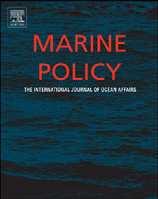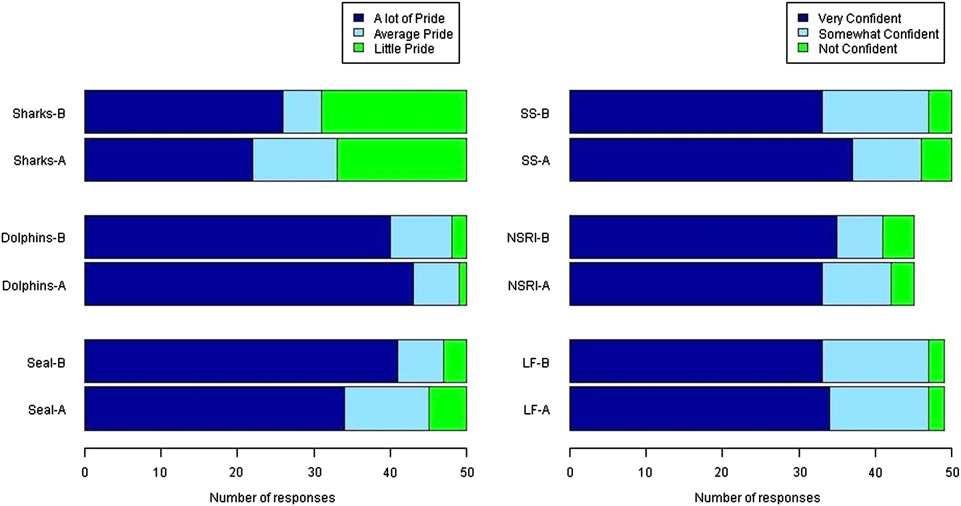
ShortCommunication
Contentslistsavailableat SciVerseScienceDirect


ShortCommunication
Contentslistsavailableat SciVerseScienceDirect
journalhomepage: www.elsevier.com/locate/marpol

Sharkbitesandpublicattitudes:Policyimplicationsfromthefirstbefore andaftersharkbitesurvey
ChristopherL.Neff a,n,JeanY.H.Yang b
a DepartmentofGovernmentandInternationalRelations,UniversityofSydney,H04MerewetherBuilding,Room263,NSW2006,Australia b SchoolofMathematicsandStatistics,UniversityofSydney,F07CarslawBuilding,Room824,NSW2006,Australia
articleinfo
Articlehistory: Received30May2012 Receivedinrevisedform 22June2012
Accepted22June2012
Keywords: Shark Sharkbite Publicperception Survey Sharkconservation Publicpolicy
abstract
Publicfeelingstowardsharksareexpectedtogrownegativelyfollowingsharkbitesonhumans.Media andgovernmentresponsesareoftenpredicatedonthispresumptiveemotionalresponse;however, therehavebeennopublisheddataonattitudestowardsharksfollowingsharkbiteincidents.Thisstudy showsthatlevelsof‘‘pride’’inwhitesharkpopulationsintheabsenceofanincidentremainedsteady afterasharkbiteoccurred.Thiswasconsistentacrossresponseareasregardingothermarinelifeand ‘‘confidence’’inbeachsafetyprograms.ResultsarebasedonapilotsurveyconductedintheCapeTown beachsuburbsofFishHoekandMuizenbergbeforeandafterasharkbiteatFishHoekbeach.Thestudy foundnostatisticalsignificancebetweensurveyresponsesandtheoccurrenceofthesharkbite incident.Theresultsindicateapreviouslyundocumentedlevelofpublicsophisticationfollowingthese events.Thisdatachallengestheunderlyingbasisofpolicyresponsestosharkbitesandsuggeststhat newconsiderationsofpublicknowledge,endemicvalueandcausalnarrativesshouldbeincorporated intodecisionmaking. & 2012ElsevierLtd.Allrightsreserved.
Policyresponsesthatkillsharksfollowingsharkbiteincidents underminethesuccessofsharkconservationcampaigns.These responsesreinforcenegativestereotypesaboutsharksandare oftenbasedoneffortstoavoidblamewhilerespondingtopublic outcry [1].However,theevidenceofconcernaboutsharks followingsharkbiteshaslargelybeenbasedonmediaaccounts andtourismworries.Thispaperreportstheresultsofthefirst surveyconductedbeforeandafterasharkbite.Respondentsin thebeachcommunitiesofFishHoekandMuizenberginCape Town,SouthAfrica,weresurveyedinJuneandOctober2011 followingasharkbiteinSeptember.Basedontheresultsofthe data,thispaperarguesthatsharkbitepolicyresponseconsiderationsshouldincludethedegreeofpublicsophisticationpresent, thevalueattributedtoendemicsharkpopulationsandthe importantroleofclearcausalstoriestoinformthepublic.
Previousresearchhaslookedatpublicperceptionsofsharks withregardstotheirwildlifevalue [2],sharkfinning [3] and mediadiscourseofsharksovertime [4].Giventhesensationalized portrayalofsharkbites,publicsupportinfavorofsharkshasbeen hindered [5].A1996SeaWebsurveyfoundthatonly30percentof
n Correspondingauthor.Tel.: þ 61424440227;fax: þ 61293513624. E-mailaddresses: Christopher.neff@sydney.edu.au(C.L.Neff), Jean.yang@sydney.edu.au(J.Y.H.Yang).
0308-597X/$-seefrontmatter & 2012ElsevierLtd.Allrightsreserved. http://dx.doi.org/10.1016/j.marpol.2012.06.017
respondents‘‘feltthatkillingsharkswasaseriousproblem’’ [6] Followingthe2001‘‘SummeroftheShark,’’ [7] a2003,asurvey bytheNationalAquariuminBaltimore,foundthat‘‘morethan80 percentsaidsharkpopulationsare‘justright’or‘toohigh’’’[8]. However,nostudyhassurveyedpublicfeelingstowardsharks directlyfollowingasharkbiteonhumans.
Thedifficultiesincollectingthisdataareclear.Predicting whereasharkbitemayoccur,obtainingabaselinesurveyofthat locality,andthenrepeatingthesurveyfollowinganincidentare significantchallenges.Yetsuchdatahasimplicationsforshark conservationsciencesinceexplanatoryvariablesmayprove effectiveatmitigatingoverreactionsfromthepublicorpoliticians andprovideinsightstowardsharkconservationeducation.A recentspikeinfatalsharkbiteincidentshighlightsthevalueof suchresearchaspolicyresponsestoseveraloftheseevents includedtheincreasedapplicationoflethalsharkcontrolmethods.Sharkbiteincidentsin2010and2011ledtoeffortstokill sharksthroughsharkhunts(orlong-linecullings)inEgyptin 2010aswellasRussia,theSeychelles,Mexico,andReunionIsland in2011 [9].InWesternAustralia,sharkhuntstookplacein2011 and2012followingfatalsharkbiteincidentsbutdidnotresultin anysharksbeingcaught.Supportfortheuseofsharknetson beachestomitigatesharkbiteshasalsorisen.Proposalstoinstall netsinVietnam(QuyNhonBeach),ReunionIsland,Russia (Primorye)andAustralia(BelmontBaths)arebeingconsidered. ThecityofCapeTownendorsedthetrialofnon-lethalexclusion netsatFishHoekbeachfollowingannon-fatalincidentin2011.
Pleasecitethisarticleas:NeffCL,YangJYH.Sharkbitesandpublicattitudes:Policyimplicationsfromthefirstbeforeandaftershark bitesurvey.Mar.Policy(2012),http://dx.doi.org/10.1016/j.marpol.2012.06.017
C.L.Neff,J.Y.H.Yang/MarinePolicy
Thispaperreviewspublicsentimentbeforeandafterthis incident.
SurveyswerecollectedintheCapeTownbeachcommunities ofFishHoekandMuizenberg.Locatedinthebiodiversityhotspot ofFalseBay [10],thesebeachesareapproximately14kmfrom SealIsland,whichishometoacolonyof‘‘upto75,000’’ [11] Cape furseals Arctocephaluspusillus andseasonalpopulationsofgreat whitesharks [12], Carcharodoncarcharias.Bothbeachlocations haveahistoryofsharkbiteincidentsonhumans.Since2004,Fish HoekhasexperiencedthreeincidentsthatresultedintwofatalitiesandMuizenberghashadoneseriousincident.
Tragiccoincidencesallowedforasmall-N pilotsurveythat includedabaselineandfollow-upsurveyofthesebeach
Table1
Shark‘‘pride’’surveyresponses.Columns2and3showlevelsof‘‘pride’’forsharks beforeandafterthesharkbiteincident,respectively.The p-value0.311indicates theacceptanceofthenullhypothesisthatthetwovariables‘‘levelofpride’’and ‘‘sharkbite’’areindependent.
Levelsof‘‘pride’’insharksBeforesharkbiteAftersharkbite (28September)
Littlepride n ¼ 19 n ¼ 17
Averagepride n ¼ 5 n ¼ 11 Alotofpride n ¼ 26 n ¼ 22
Table2
Seal‘‘pride’’surveyresponses.Columns2and3showlevelsof‘‘pride’’forseals beforeandafterthesharkbiteincidentrespectively.Thelastrowhighlights‘‘alot ofpride’’responsesamongmales(M)andfemales(F).Thequantitativeanalysis (p-value ¼ 0.259)suggeststhatthetwovariables‘‘levelofpride’’and‘‘sharkbite’’ areindependent.
Levelsof‘‘pride’’insealsBeforesharkbiteAftersharkbite (28September)
Littlepride n ¼ 3 n ¼ 5
Averagepride n ¼ 6 n ¼ 11
Alotofpride n ¼ 41(M ¼ 23,F ¼ 18) n ¼ 34(M ¼ 15,F ¼ 19)
communities.OnJune22,2011asurveyofrespondentsinFish Hoek(n ¼ 25)andMuizenberg(n ¼ 25)wasconductedregarding theirlevelof‘‘prideinthelocalmarinelife,’’includingseals, dolphinsandsharks.Theterm‘‘pride’’wasselectedtobuildupon existingliteraturewhichnotestheimportanceofendemicvalue tospeciesconservation [13].Thesurveyalsomeasuredlevelsof ‘‘confidence’’inbeachsafetyeffortsofferedbySurfLifesavers, SharkSpottersandtheNationalSeaRescueInstitute(NSRI).A Likert-typescalewasusedandresponseswereenteredintoSPSS forinitialprocessingandlaterinto R forstatisticalanalysis. P-valuesfor Tables1and2 arecalculatedusingFisherExacttest. OnSeptember28,2011,themostrecentsharkbitetookplaceat FishHoekonanadultmale,whichcausedthelossofpartsofboth legs.Thistookplaceafterasharkwasspottedandthebeachwas closed;however,arotatingpowerblackoutprohibitedashark alarmfrombeingsounded [14].Followingtheincident,this surveywasrepeatedonOctober13,2011inbothlocationsto thesamenumberofrespondents(n ¼ 50).
Toassesspublicattitudes,one-on-onesurveystookplaceat grocerystoresadjacenttothebeaches(theShopriteinFishHoek andCheckersinMuizenberg).Thedemographicbreakdownof respondentsincluded49malesand51females,43whiterespondents,33Black-SouthAfricanrespondentsand24peopleofcolor. Theagebreakdownincluded36respondents(ages18–25),40 respondents(ages26–40),and24respondents(ages40–75). Thosesurveyedwereasked,‘‘Onascaleof1–10,howmuchpride doyouhaveinthelocalmarinelife?’’,and‘‘howconfidentareyou inlocalbeachsafety?’’Pridelevelswereidentifiedandcodedas ‘‘littlepride’’(1–3),‘‘averagepride’’(4–6)and‘‘alotofpride’’(7–10). Thesamedistributionwasusedforconfidencelevels‘‘notconfident’’(1–3),‘‘somewhatconfident’’(4–6)and‘‘veryconfident’’ (7–10).Analysisofborderlinenumbers‘‘4’’and‘‘7’’showed minimaluse.Ifrespondentsaskedwhat‘‘pride’’referredto,the word‘‘support’’wasusedtoconveythepoint.
Thisstudyutilizedqualitativeandquantitativemeasurements. Thequalitativedataindicatethatlevelsofprideforsharksare unchangedfollowingthesharkbiteincident,asseenin Table1. Thisconsistencyisalsoseeninresponsesfordolphins(Fig.1).In addition,degreesofconfidenceinSurfLifesavers,SharkSpotters

Fig.1. Sharkbite‘‘beforeandafter’’surveyresponsesto‘‘pride’’amonganimalspeciesand‘‘confidence’’ofbeachsafetymeasures.Leftpanel:variablesarenotedto indicatesurveyresponsestosharks,dolphinsandseals‘‘B’’(before)and‘‘A’’(after).Theseinclude‘‘alotofpride’’(black),‘‘averagepride’’(lightgray)and‘‘littlepride’’ (darkgray).Rightframe:variablesarenotedtoindicatesurveyresponsestoSharkSpotters(SS),NationalSeaRescueInstitute(NSRI)andFishHoekSurfLifesaving(LF). Theseinclude‘‘veryconfident’’(black),‘‘somewhatconfident’’(lightgray)and‘‘notconfident’’(darkgray).
Pleasecitethisarticleas:NeffCL,YangJYH.Sharkbitesandpublicattitudes:Policyimplicationsfromthefirstbeforeandaftershark bitesurvey.Mar.Policy(2012),http://dx.doi.org/10.1016/j.marpol.2012.06.017
C.L.Neff,J.Y.H.Yang/MarinePolicy
andNSRIarealsounchanged.Whilelevelsofsupportforsharks arelowerthanthosefordolphinsorseals,theygonolowerand levelsofpridefordolphinsarehighandstayhigh.Oneexception isnotedregardingthelevelofprideinseals.Empirically,there appearstobeanincreaseinnegativeindicatorsforseals,includingmore‘‘littlepride,’’more‘‘averagepride’’andfewer‘‘alotof pride’’responses(Table2);inparticular,maleswerelesssupportiveofsealsinthe‘‘alotofpride’’category.
Theobservedquantitativedataimpliesthatthereisno statisticallysignificantconnectionbasedonFisherexacttest betweenthelevelsof‘‘pride’’orlevelsof‘‘confidence’’andthe occurrenceofthesharkbiteincident(p-value ¼ 0.311).Itwas expectedthattherewouldbeastrongnegativerelationship betweenprideinlocalsharkpopulationsandthefrequencyor proximityofsharkbiteincidents;however,theseresultsdonot supportthatexpectation.
4.Discussion
Theresultsdemonstratethatpublicattitudestowardsharks shouldbeconsideredmoresophisticatedthanpreviouslythought andthatattitudestowardsharksmaybeindependentofthe occurrenceofsharkbiteincidents.Thelimitedsamplesizes involvedmaybeafactorinthelackofstatisticalsignificance; however,theinsignificanceacrossallvariablesandthequalitative consistencyobservedsupportstheindependenceofsharkbites asavariable.Clearly,theuseoflargersamplesizesinfuture researchwillprovidevaluableinformationintestingthese results.
Therearecaseswheresharkbitesmayresultindecreased supportforsharksandpublicoutrage.However,thisstudyshows thatthisisnotalwaysthecaseandmayofferassistanceto governmentsrespondingtotragicsharkfatalities.Severalpoints areinstructiveforconsideringfutureresponsestosharkbites. First,localrespondentsdidnotappeartoholdsharksorgovernment-fundedbeachsafetyprograms(suchastheSharkSpotters) responsiblefortheincident.Researchthatarguesthatincumbent politiciansmayirrationallybeblamedbythepublicforshark bites [15] andthatpolicyover-reactionsarerequiredtoprotect governmentsfrompotentialblame [16] areofferedanalternative perspectivebythisresearch.Secondly,thedeclineinsupportfor sealsoffersasnapshotofpublicattributionofblamebasedon alternativelyadequatecausation.Asaresult,newconsiderations regardingresponsestosharkbitesmayincludepublicunderstanding,localexperiencewithsharksandthedetailsofan incident.Togethertheseofferaholisticviewofsharkbitesthat acknowledgetheecologicaltotalityrequiredtobringhumansand sharkstogether.Finally,additionalattentionfromscientistsand policymakerstowardtheinvestigationandexplanationofshark bitesmaygivenewmeaningtotheseeventsandplacethemin qualifiedcategoriesinthefuture.
5.Conclusion
Thisresearchsuggeststhatsharkbitesdonotalwaysproduce negativeemotionalresponsestowardsharksorgovernments
whenanadequatecausalstoryispresent.Asaresult,thepolitics ofsharkbitesandtheselectionofpolicyresponsesshould considermethodsofsharkbitepreventionandbeachsafetythat informthepublicbeforeandaftertheseincidentsoccur.Public sophisticationofthedynamicnatureofbeachecosystemsmakes communicatingthesenarrativespossible.Greaterstudyis needed,yetthissurveyaffirmsthekeyrolethattheendemic valuetowardsharksplays,evenfollowingsharkbitesonhumans. Thisdatamayprovidevaluableinsightforthedirectionof broadersharkconservationeducation.
ThisworkwassupportedbytheSaveOurSeasFoundation,the SydneyAquariumConservationFundandtheUniversityof SydneyFacultyofArtsandSocialSciences.Specialappreciation isextendedtoJakeSearleandPaulMillarfortheirassistancein collectingthesurveydata.AlisonKockandAllegraGellerare thankedfortheirencouragementaswellasAssociateProfessor RodneySmithforhishelpfulcomments.
[1]NeffC.Australianbeachsafetyandthepoliticsofsharkattacks.CoastManage 2012;40:88–106.
[2]KellertS.Publicperceptionsofpredators,particularlythewolfandcoyote. BiolConserv1985;31:167–189.
[3]SpruillVUS.Publicattitudestowardmarineenvironmentalissues.Oceanography1997;10:149–152.
[4]BoissonneaultMF,GladstoneW,PaulS,CushingN.Greynursesharkhuman interactionsandportrayals:astudyofnewspaperportrayalsofthegrey nursesharkfrom1969-2003.ElectronGreenJ2005;22:1–21.
[5]ThompsonT,MintzesJ.Cognitivestructureandtheaffectivedomain:on knowingandfeelinginbiology.IntJSciEduc2010;24:645–660.
[6]SpruillVUS.Publicattitudestowardmarineenvironmentalissues.Oceanography1997;10:149–152.
[7]Timemagazine.Summeroftheshark(cover)July30,2001. /http://www. time.com/time/magazine/0,9263,7601010730,00.htmlS
[8]NationalAquariumofBaltimore.Americanshookedonsharkmyths:national surveyshowspeopleknowlittleaboutsharks.’’Pressrelease,Baltimore,MD. May14,2003.RetrievedMay6,2012.
[9]EilperinJ.Sharkstrikepromptslethalhunt,evenassomecallforconservation. TheWashingtonPost;October26,2011. /http://www.washingtonpost.com/ national/health-science/shark-strikes-prompt-lethal-hunt-even-as-some-callfor-conservation/2011/10/24/gIQAjES7GM_story.htmlS
[10]CowlingRM,MacdonaldAW,SimmonsMT.TheCapePeninsula,SouthAfrica: physiographical,biologicalandhistoricalbackgroundtoanextraordinary hot-spotofbiodiversity.BiodiversConserv1996;5:527–550.
[11]AvianDemographyUnitwebsite.DepartmentofStatisticalSciences.UniversityofCapeTown,2003. /http://web.uct.ac.za/depts/stats/adu/sealfbay. htmS
[12]MartinA,HammerschlagN.Marinepredator–preycontests:ambushand speedversusvigilanceandagility.MarBiolRes2012;8:90–94.
[13]MeuserE,HarshawH,MooersA.PublicPreferenceforEndemismoverOther Conservation-RelatedSpeciesAttributes.ConservBiol2009;4:1041–1046.
[14]CityofCapeTown.ReportandreviewofeventsatFishHoekBeachaftergreat whitesharkincident28September2011.September29,2011. /http:// sharkspotters.org.za/?s=skinnerS
[15]AchenC.,BartelsL.M.Blindretrospection:electoralresponsestodrought,flu andsharkattacks.Estudio/workingpaper;2004.p.1-39. /http://www. march.es/ceacs/publicaciones/working/archivos/2004_199.pdfS
[16]NeffC.Australianbeachsafetyandthepoliticsofsharkattacks.Coast Manage2012;40:88–106.